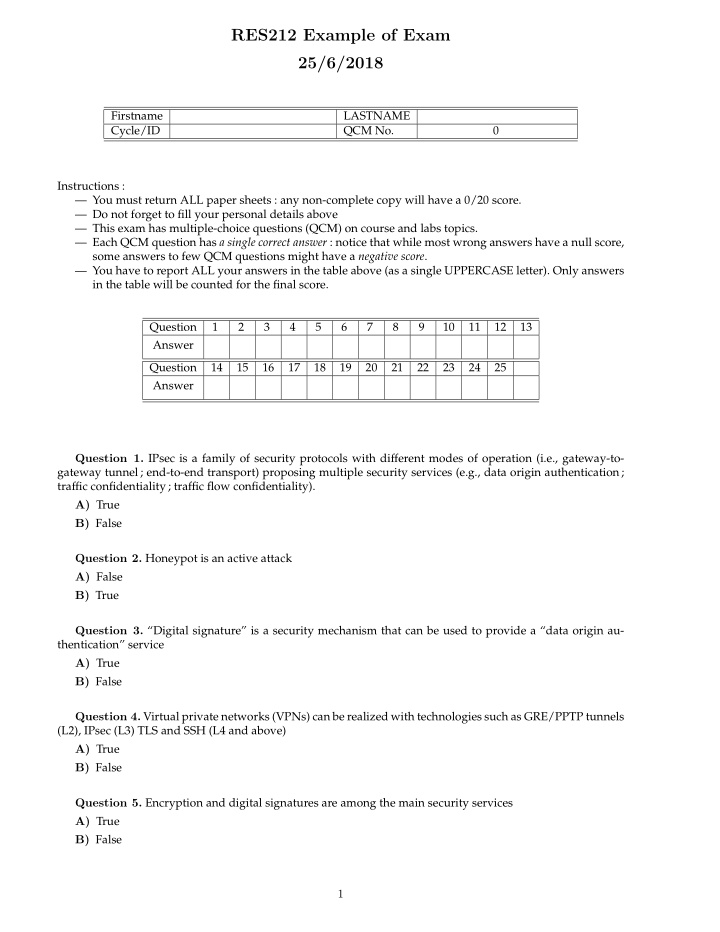



RES212 Example of Exam 25/6/2018 Firstname LASTNAME Cycle/ID QCM No. 0 Instructions : — You must return ALL paper sheets : any non-complete copy will have a 0/20 score. — Do not forget to fill your personal details above — This exam has multiple-choice questions (QCM) on course and labs topics. — Each QCM question has a single correct answer : notice that while most wrong answers have a null score, some answers to few QCM questions might have a negative score . — You have to report ALL your answers in the table above (as a single UPPERCASE letter). Only answers in the table will be counted for the final score. Question 1 2 3 4 5 6 7 8 9 10 11 12 13 Answer Question 14 15 16 17 18 19 20 21 22 23 24 25 Answer Question 1. IPsec is a family of security protocols with different modes of operation (i.e., gateway-to- gateway tunnel ; end-to-end transport) proposing multiple security services (e.g., data origin authentication ; traffic confidentiality ; traffic flow confidentiality). A) True B) False Question 2. Honeypot is an active attack A) False B) True Question 3. “Digital signature” is a security mechanism that can be used to provide a “data origin au- thentication” service A) True B) False Question 4. Virtual private networks (VPNs) can be realized with technologies such as GRE/PPTP tunnels (L2), IPsec (L3) TLS and SSH (L4 and above) A) True B) False Question 5. Encryption and digital signatures are among the main security services A) True B) False 1
Question 6. The Transport Layer Security (TLS) record protocol computes the Message Authentication Code (MAC) over : A) transmitted encrypted data, transmitted record header, non-transmitted sequence number B) transmitted unencrypted data, transmitted record header, non-transmitted sequence number C) transmitted encrypted data, transmitted record header, transmitted sequence number D) transmitted unencrypted data, transmitted record header, transmitted sequence number Question 7. In computer security, an ingress firewall is used to typically check compliance of user traffic with some policy A) False B) True Question 8. Firewalls can perform different operations on the screened traffic. An application gateway nor- mally performs : flow tracking, L7 payload parsing, state machine reconstruction ; A) False B) True Question 9. The IPsec Encapsulated Security Payload (ESP) protocol, in addition to the services offered by the IPsec Authentication Header (AH) protocol, offers A) Traffic flow confidentiality only B) Data confidentiality only integrity C) Data and Traffic flow confidentiality Question 10. In iptables/netfilter, when packets trigger conditions that yield to a ACCEPT action, one must still take care that the traffic in the reverse direction is properly handled (e.g., using the circuit-level logic provi- ded by the state or conntrack modules) A) False B) True Question 11. A hash function has a variable-length input and a fixed-length output A) True B) False Question 12. Security attacks can be broadly characterized as either passive or active attacks A) True B) False Question 13. Network intrusion prevention sytems (NIPS) complement the operation of Network intru- sion detection sytems (NIDS) by providing fast and fully automated response to alerts generated by the latter A) False B) True Question 14. Public Key Infrastructures (PKI) are used to distribute and verify X.509 certificates, and have no known cryptographic or protocol weaknesses A) True B) False Question 15. iptables/netfilter are respectively a Linux kernel module and a user-space firewall applica- tion used to configure iptables kernel hooks 2
A) False B) True Question 16. Multi-protocol Label Switching (MPLS) is a technology that ISPs can use to implement Vir- tual Private Network (VPNs), that helps in switching and isolating traffic of different VPNs A) True B) False Question 17. In IPsec, the parameters of the Security Association (SA) negociated via the Internet Key Exchange (IKEv2) protocol A) are proposed as a list by the initiator, and are ultimately selected by the responder B) are proposed as a list by the responder, and are ultimately selected by the initiator Question 18. When in transport mode, the IPsec Encapsulated Security Payload (ESP) header and ESP authentication trailer encapsulate : A) the transport (TCP/UDP/etc.) and payload data (plus optionally a padding trailer) of the non- encrypted packet B) the original network header (IP), transport header (TCP/UDP/etc.) and payload data (plus optionally a padding trailer) of the non-encrypted packet C) the transport header (TCP/UDP/etc.) and payload data (plus optionally a padding trailer) of the en- crypted packet D) the original network header (IP), transport header (TCP/UDP/etc.) and payload data (plus optionally a padding trailer) of the encrypted packet Question 19. Output FeedBack (OFB) mode is a mode of operation of block ciphers that offers confiden- tiality, and its use can still be recommended today, since (with proper initialization) it is still cryptographically safe A) False B) True Question 20. The Transport Layer Security (TLS) handshake message sequence comprises 4 phases : in case of an abbreviated exchange to refresh the key material, some of these phases can be skipped A) True B) False Question 21. The Transport Layer Security (TLS) protocol is immune to the SSL/STARTTLS stripping attacks provided that a HTTP Strict Transport Security (HSTS) header is present in the first connection to a domain A) False B) True Question 22. X.509 certificates contain, among other fields, the Certification Authority (CA) identity, the User identity and public key, a cryptographic digest of all the certificate, and finally the same digest encrypted with the CA private key A) False B) True Question 23. Authentication, access control, data confidentiality and non repudiation are among the main security mechanisms A) False 3
B) True Question 24. One of the primary goals of asymmetric key cryptography is to digitally signs objects (pro- viding authentication, integrity protection and non-repudiation) A) False B) True Question 25. The Transport Layer Security (TLS) handshake message sequence comprises 4 phases : in the 1st phase, the client selects one among the cipher algorithms proposed by the server A) True B) False 4
Recommend
More recommend